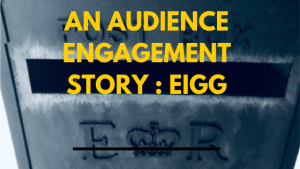“What is preventing rural audiences from having the best possible experience of new work touring to their communities?” We asked ourselves. Read about our Process, Design Thinking and Our Inter-relational Triangle used for devising new pieces of work.
Written by – Lisa Baxter, The Experience Business
BRAW is an open-ended enquiry into how we might support more artistically vibrant new work for rural audiences in Scotland, created in response to findings from Creative Scotland’s Touring Review 2017 [see below]
The question we asked ourselves was, ‘
What is preventing rural audiences from having the best possible experience of new work touring to their communities?’
There is no single answer, but we focussed on this one – a touring system in which artists, promoters and audiences were operating with little or no understanding of each other’s worlds, priorities or goals.

Artists would understandably focus on their artistic process, but with the majority working in urban contexts, many had limited or no understanding of rural audiences or the challenges promoters face.
Promoters were intent on finding and selling good quality work, but with a limited understanding of the work itself.
Audiences booked for the work on the basis of extremely limited, poorly targeted information that did not set the right expectations for their experience.
We decided, therefore, to design a programme that connected these three key stakeholders in a more durational, invested way. We wanted to improve mutual understanding by supporting richer dialogue and exchange between them; more a ‘to-and-fro’ than a ‘tell-and-sell’.
We wanted to bring the devising process out from behind closed doors. And we wanted a more openly iterative process of developing the work with audiences and promoters during the devising phase.
The structure of the programme we created was loosely based on Design Thinking,
At its simplest level, Design Thinking is an empathic innovation and problem solving process. Often referred to as human-centred design, the process employs ideation, experimentation and prototyping to develop new products and services. We wanted to explore how the iterative human-centred nature of design thinking might support the creation of artistic product better able to connect with audiences? We took each of the five steps [below] and adapted them to meet our aims.
Empathise
We planned to kick-start the programme with a three day residential where the BRAW team would deepen their understanding of each other’s contexts, working processes and challenges. This was then followed by site visits, one artist per community, hosted by the promoters, where artists would observe their community and take the pulse of place.
Define
We reframed this stage from ‘defining a problem’ into developing the impetus for the work. Each artist would visit their community with a blank page and seek inspiration from the people and places they encountered. The promoter’s knowledge of their community would bring valuable access and insight.
Ideate
This stage is the equivalent of the artist’s devising process, but with a difference. The artist’s would share their ideas and the process with the promoters, who would in turn input into more practical considerations, such as performance contexts, at a very early stage.
Prototype and Test
We planned two rounds of prototyping and testing the work-in-progress with the host communities. This would give artists the chance to see how it landed at early stage development, and audiences an opportunity to meet the artists and become curious, or intrigued, or even feel invested in the work.
In designing this structure we were conscious of the issues it would raise for the artists. The requirement to create a new piece of work in response to a specific place or community might feel ‘forced’ and result in work that inhibits their artistic integrity. Prototyping and testing places artists in a vulnerable position, and the requirement to listen and adapt to the audiences responses could result in a dumbing down of the work.
Our belief is that through this process, artists will be more able to create work that resonates with rural audiences without a dilution of artistic integrity. Rather than detracting from their artistic process, this empathy with people and place will serve as an additional layer with which to inform and enrich it. The testing of that work at early stage development, rather than inhibit the artists, may well inform risk taking because those artists will have developed an understanding of how and to what degree they might ‘stretch’ their audiences.
By working in this much more connected way, our hope is that artists might create work with enhanced potential to appeal to, and resonate with, rural communities, promoters would be able to communicate that work much more insightfully and rural audiences would have access to new work that, in some way, is more relevant, meaningful or vibrant.
Read more from BRAW below























